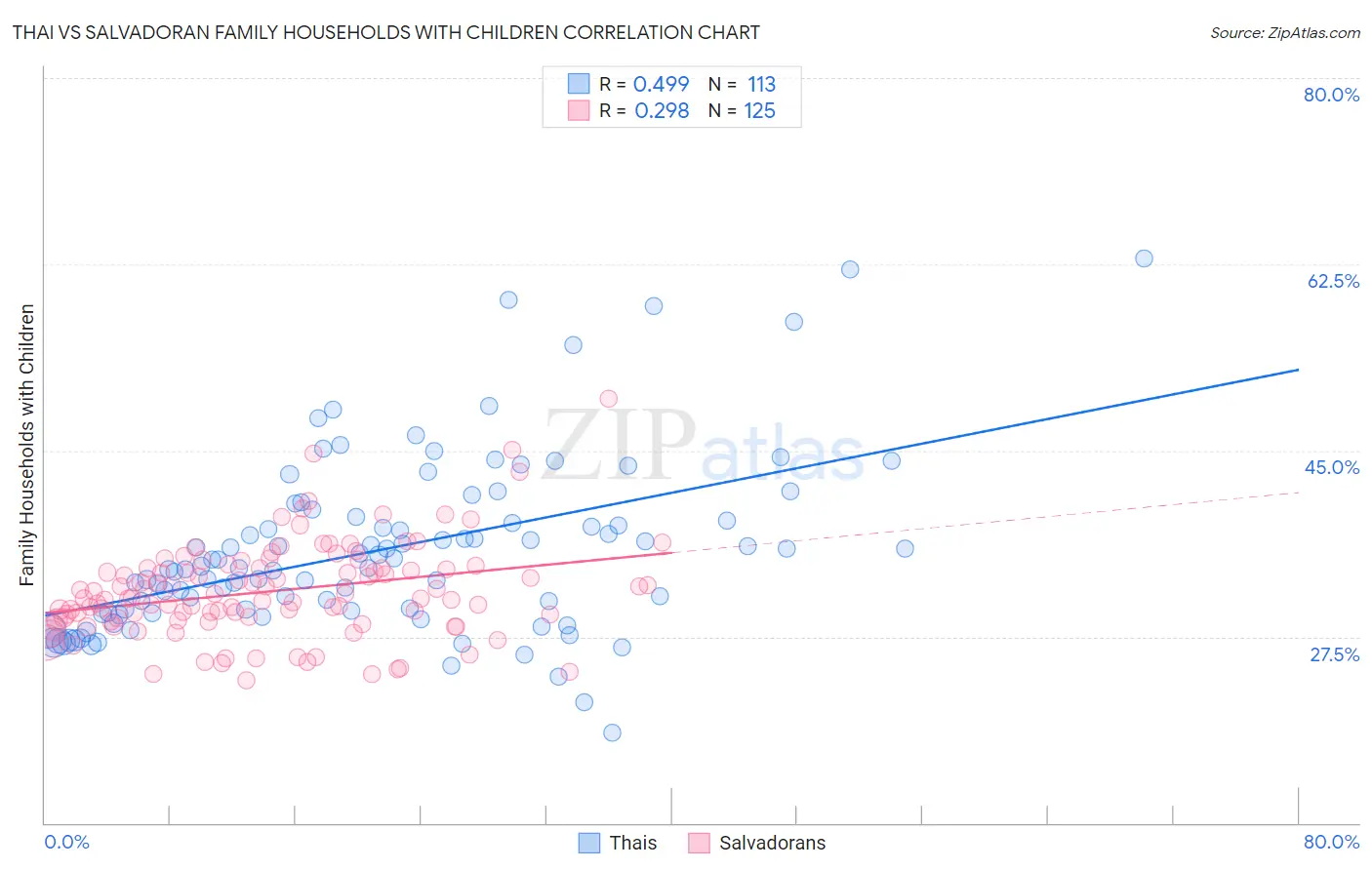Thai vs Salvadoran Family Households with Children
COMPARE
Thai
Salvadoran
Family Households with Children
Family Households with Children Comparison
Thais
Salvadorans
30.6%
FAMILY HOUSEHOLDS WITH CHILDREN
100.0/ 100
METRIC RATING
9th/ 347
METRIC RANK
29.9%
FAMILY HOUSEHOLDS WITH CHILDREN
100.0/ 100
METRIC RATING
18th/ 347
METRIC RANK
Thai vs Salvadoran Family Households with Children Correlation Chart
The statistical analysis conducted on geographies consisting of 475,181,925 people shows a moderate positive correlation between the proportion of Thais and percentage of family households with children in the United States with a correlation coefficient (R) of 0.499 and weighted average of 30.6%. Similarly, the statistical analysis conducted on geographies consisting of 398,611,011 people shows a weak positive correlation between the proportion of Salvadorans and percentage of family households with children in the United States with a correlation coefficient (R) of 0.298 and weighted average of 29.9%, a difference of 2.6%.

Family Households with Children Correlation Summary
| Measurement | Thai | Salvadoran |
| Minimum | 18.5% | 23.4% |
| Maximum | 63.0% | 49.9% |
| Range | 44.5% | 26.5% |
| Mean | 35.6% | 31.8% |
| Median | 34.1% | 31.1% |
| Interquartile 25% (IQ1) | 29.8% | 29.2% |
| Interquartile 75% (IQ3) | 38.6% | 34.0% |
| Interquartile Range (IQR) | 8.8% | 4.8% |
| Standard Deviation (Sample) | 8.2% | 4.5% |
| Standard Deviation (Population) | 8.2% | 4.5% |
Demographics Similar to Thais and Salvadorans by Family Households with Children
In terms of family households with children, the demographic groups most similar to Thais are Immigrants from Fiji (30.5%, a difference of 0.32%), Nepalese (30.5%, a difference of 0.40%), Yakama (30.8%, a difference of 0.48%), Immigrants from Central America (31.0%, a difference of 1.1%), and Immigrants from Pakistan (30.2%, a difference of 1.3%). Similarly, the demographic groups most similar to Salvadorans are Alaska Native (29.9%, a difference of 0.040%), Immigrants from El Salvador (29.8%, a difference of 0.070%), Immigrants from Laos (29.8%, a difference of 0.11%), Malaysian (29.8%, a difference of 0.14%), and Hispanic or Latino (29.9%, a difference of 0.19%).
| Demographics | Rating | Rank | Family Households with Children |
| Immigrants | Mexico | 100.0 /100 | #3 | Exceptional 31.6% |
| Mexicans | 100.0 /100 | #4 | Exceptional 31.4% |
| Tongans | 100.0 /100 | #5 | Exceptional 31.2% |
| Immigrants | India | 100.0 /100 | #6 | Exceptional 31.0% |
| Immigrants | Central America | 100.0 /100 | #7 | Exceptional 31.0% |
| Yakama | 100.0 /100 | #8 | Exceptional 30.8% |
| Thais | 100.0 /100 | #9 | Exceptional 30.6% |
| Immigrants | Fiji | 100.0 /100 | #10 | Exceptional 30.5% |
| Nepalese | 100.0 /100 | #11 | Exceptional 30.5% |
| Immigrants | Pakistan | 100.0 /100 | #12 | Exceptional 30.2% |
| Afghans | 100.0 /100 | #13 | Exceptional 30.2% |
| Bangladeshis | 100.0 /100 | #14 | Exceptional 30.1% |
| Immigrants | South Central Asia | 100.0 /100 | #15 | Exceptional 30.0% |
| Immigrants | Afghanistan | 100.0 /100 | #16 | Exceptional 30.0% |
| Hispanics or Latinos | 100.0 /100 | #17 | Exceptional 29.9% |
| Salvadorans | 100.0 /100 | #18 | Exceptional 29.9% |
| Alaska Natives | 100.0 /100 | #19 | Exceptional 29.9% |
| Immigrants | El Salvador | 100.0 /100 | #20 | Exceptional 29.8% |
| Immigrants | Laos | 100.0 /100 | #21 | Exceptional 29.8% |
| Malaysians | 100.0 /100 | #22 | Exceptional 29.8% |
| Mexican American Indians | 100.0 /100 | #23 | Exceptional 29.7% |